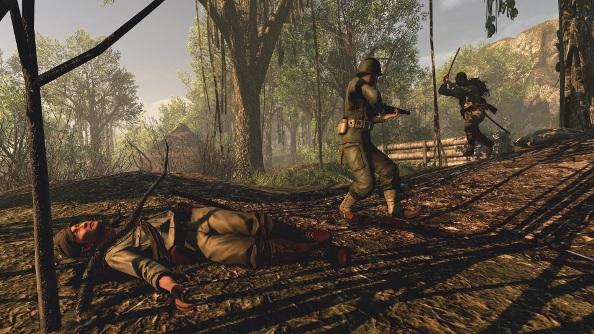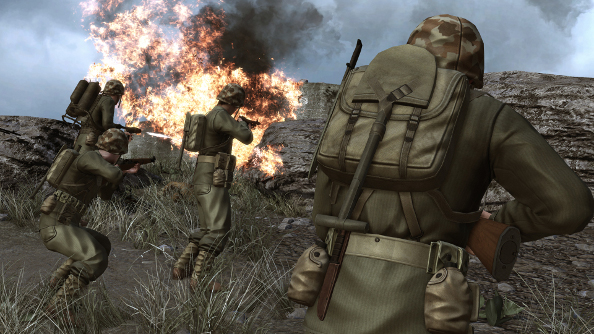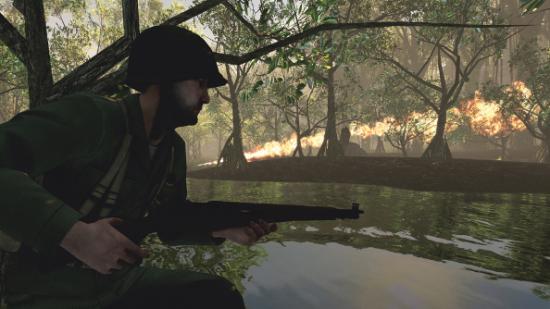Red Orchestra 2: Rising Storm faces an interesting problem: how do you make a balanced, historically accurate team-based multiplayer shooter out of the Pacific theater, where the defining feature of the land battles was their complete imbalance?
I spent an hour at GDC playing around with some of new American weapons and watching producer Tony Gillham playing the Japanese side. I was struck both by how cleverly Tripwire’s Rising Storm team are adapting features of the Pacific war into novel game mechanics, and the drastically asymmetrical tactics those mechanics impart to the game. I have my doubts that Rising Storm can be effectively balanced, but having seen it in action, that seems like a good thing.
While Japan went to war against the United States with a first-rate navy, its army much more closely resembled something from World War I than the mechanized land forces of Europe and United States. It was a bolt-action rifle and bayonet infantry force, with limited machine gun support, poor-quality submachine guns, and no rapid-fire rifles like the American M1 and BAR. Japanese troops were routinely at a huge firepower disadvantage, particularly toward the end of the war.
All of which makes for interesting military history, but not necessarily a great team FPS. Even in the early days of Red Orchestra 2, there was some grumbling from players who found themselves on the Soviet side of matches, who felt German small-arms tended to be a bit better and tilted the balance of matches their way. That was a war between two fairly equal opponents, so how can Rising Storm make a good game out of a contest between bolt-action rifles versus semi-automatics?
Don’t discount those bolt-actions too hastily, warned Gillham. “If I’m going to fight a bolt-action, I actually quite like to fire the Type 38 Japanese rifle. Personally, that’s a real favorite. Not too much kick, not too much recoil. You can fire off a round and pretty much zoom right back in again.”

The other part of the answer lies in playing up Japan’s particular strengths and favored tactics. While the Japanese may not have enjoyed much in the way of firepower, they did make use of grenade launchers. In Rising Storm 2, Japanese squads will usually have a couple grenade launchers to go around, capable of being used as direct-fire weapons or pointed skyward for use as an improvised mortar. The Japanese Type 99 grenade, meanwhile, had an unusual fuse design that allowed it to be used as a booby trap. Players will be able to set their grenades on the ground and wait for an American to run over it, or sit nearby and shoot it, making it a sort of IED.
The main weapon in the Japanese players’ arsenal, however, is the banzai charge. While the banzai charge was a disaster for the Japanese army during the war (by the end of the war, Japanese commander were throwing away thousands of Japanese lives in human-wave attacks against fixed positions), in Rising Storm is occupies an interesting tactical niche. In keeping with the reputation Japanese troops developed for fearlessness (under normal circumstances, the Japanese players are slightly less affected by suppression), and the unnerving effect the banzai charge had on its enemies, a Japanese officer can activate a banzai charge ability and grant suppression and fatigue resistance to his team and increase the suppression on American players, making them less accurate in combat.
“The Japanese are intrinsically less-suppressed,” said Gillham. “Not much. Just enough to make a difference. When you couple that with things like the banzai mechanic, where he’s really not suppressed, and the American guy is basically crapping himself, then that really redresses that balance.”
The catch is that the banzai charge is just that: a charge. You can’t activate it like a buff spell, you actually need an officer running at the head of his troops with katana drawn, screaming his lungs out as they advance against the enemy.

It’s not an easy way to fight. I watched the developer get cut down a few times before he finally made it inside American lines and started carving up GIs. In fact, everything about the Japanese side of the game seems to take a bit more skill and coordination. Even allowing for the fact that the US Marines Corps was under-equipped in the early stages of the war, it doesn’t seem like the Japanese side will fare well in battles between two equally skilled teams.
The Americans have a new tool of their own, the flamethrower, which was quite a lot of fun to use. But perhaps the main thing working to keep the game balanced is the harsh-terrain of the Pacific theater. From the the American perimeter at Guadalcanal at night to the black sands of the Iwo Jima beachhead, Rising Storm features some challenging battlefields that will give Japanese players a chance to negate the US fire-power advantage.
It may also require some careful objective placement and scenario design. In many ways Rising Storm reminds me more of a wargame than a military shooter, and it confronts many of the same problems that bedevil wargame design. In any remotely realistic simulation, the Japanese forces should lose the majority of their land battles against the United States, just like the Soviets should get slaughtered during the opening phases of Barbarossa and the Germans don’t have a snowball’s chance in hell of achieving victory in the Battle of the Bulge. Much of warfare, with a handful of famous exceptions, consists of bloody grinding toward a foregone conclusion.
Where things get interesting is in the “can you do better?” department. The Germans will lose, but can they achieve success by holding on a little longer. The Japanese may not be able to drive the Americans off Iwo Jima, but they can make the price a bit higher, and hold key objectives a little longer. Much of wargame design is making unfair fights into interesting contests of skill. To succeed, Rising Storm will need to do the same thing. Because far more than Stalingrad, Rising Storm is a game about the unfairest of fights.
